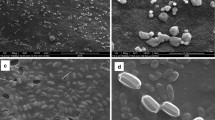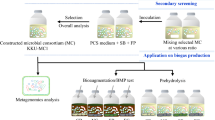Abstract
In a natural ecosystem, various organisms digest and hydrolyze lignocellulose biomass efficiently. Termites are one of them. They digest lignocellulose biomass with the help of symbiotic microorganisms in their gut. Therefore, termites gut may harbor potential sources of microorganisms capable to degrade lignocellulose biomass. In this study, termite gut microbiomes of Cryptotermes brevis species were isolated and identified for their capability to degrade lignin and polysaccharides. Alkali lignin, carboxymethylcellulose, and xylan were used as the only carbon sources in the medium to isolate lignin-, cellulose-, and hemicellulose-degrading bacteria. By this method, two bacteria strains, Bacillus sp. BMP01 and Ochrobactrum oryzae BMP03 strain were isolated and identified. Bacillus sp. BMP01 strain has capabilities to hydrolyze carboxymethylcellulose and xylan to glucose and xylose, respectively. This strain showed high xylanase activity (about 0.21 U/ml) and carboxymethyl cellulase activity (about 0.25 U/ml). The ability to hydrolyze both carboxymethylcellulose and xylan makes it superior to other known cellulolytic bacteria. Ochrobactrum oryzae BMP03 strain showed laccase activity, which indicates its ability to depolymerize lignin. Lignocellulose-degrading bacteria play a vital role in the biological conversion of lignocellulose biomass to biofuel. Overall, this study shows that termite’s gut microbiomes are potential sources of lignocellulose-degrading bacteria that can be cultured and used in the biological conversion of lignocellulose biomass to biofuel.






Similar content being viewed by others

References
Abe T, Bignell DE, Higashi T (2000) Termites: evolution, sociality, symbioses,ecology. Kluwer Academic Publishers, Dordrecht, The Netherlands
Acharya S, Chaudhary A (2011) Effect of nutritional and environmental factors on cellulase activity by thermophilic bacteria isolated from hot spring. J Sci Ind Res 70:142–148
Adams L, Boopathy R (2005) Isolation and characterization of enteric bacteria from the hindgut of Formosan termite. Bioresour Technol 96(14):1592–1598. https://doi.org/10.1016/j.biortech.2004.12.020
Amore A, Parameswaran B, Kumar R, Birolo L, Vinciguerra R, Marcolongo L, Ionata E, La Cara F, Pandey A, Faraco V (2014) Application of a new xylanase activity from Bacillus amyloliquefaciens XR44A in brewer’s spent grain saccharification. J Chem Technol Biotechnol 90(3):573–581. https://doi.org/10.1002/jctb.4589
Anjum SI, Shah AH, Aurongzeb M, Kori J, Azim MK, Ansari MJ, Bin L (2017) Characterization of gut bacterial flora of Apis mellifera from North-West Pakistan. Saudi J Biol Sci 25(2):388–392. https://doi.org/10.1016/j.sjbs.2017.05.008
Auer L, Lazuka A, Sillam-Dussès D, Miambi E, O’Donohue M, Hernandez-Raquet G (2017) Uncovering the potential of termite gut microbiome for lignocellulose bioconversion in anaerobic batch bioreactors. Front Microbiol 8:2623. https://doi.org/10.3389/fmicb.2017.02623
Ayed L, Khelifi E, Jannet HB, Miladi H, Cheref A, Achour S, Bakhrouf A (2010) Response surface methodology for decolorization of azo dye Methyl Orange by bacterial consortium: produced enzymes and metabolites characterization. Chem Eng J 165(1):200–208. https://doi.org/10.1016/j.cej.2010.09.018
Azizi-Shotorkhoft A, Mohammadabadi T, Motamedi H, Chaji M, Fazaeli H (2016) Isolation and identification of termite gut symbiotic bacteria with lignocellulose-degrading potential, and their effects on the nutritive value for ruminants of some by-products. Anim Feed Sci Technol 221:234–242. https://doi.org/10.1016/j.anifeedsci.2016.04.016
Bailey MJ, Biely P, Poutanen K (1992) Interlaboratory testing of methods for assay of xylanase activity. J Biotechnol 23(3):257–270. https://doi.org/10.1016/0168-1656(92)90074-J
Bandounas L, Wierckx NJ, de Winde JH, Ruijssenaars HJ (2011) Isolation and characterization of novel bacterial strains exhibiting ligninolytic potential. BMC Biotechnol 11(1):94 Available at: http://www.biomedcentral.com/1472-6750/11/94%0APage
Bignell DE, Anderson JM (1980) Determination of pH and oxygen status in the guts of lower and higher termites. J Insect Physiol 26(3):183–188
Brune A (2014) Symbiotic digestion of lignocellulose in termite guts. Nature Nat Rev Microbiol 12(3):168–180
Brune A, Carsten D (2015) The gut microbiota of termites: digesting the diversity in the light of ecology and evolution. Annu Rev Microbiol 69:145–166. https://doi.org/10.1146/annurev-micro-092412-155715
Chantarasiri A, Boontanom P, Yensaysuk N, Ajwichai P (2015) Isolation and identification of a cellulase-producing Bacillus sp. strain BR0302 from Thai coastal wetland soil. Kmutnb Int J Appl Sci Technol 8(3):197–203 https://www.tci-thaijo.org/index.php/ijast/article/view/67479
Connick WJ, Osbrink WL, Wright MS, Williams KS, Daigle DJ, Boykin DL, Lax AR (2001) Increased mortality of Coptotermes formosanus (Isoptera: Rhinotermitidae) exposed to eicosanoid biosynthesis inhibitors and Serratia marcescens (Eubacteriales; Enterobacteriaceae). Environ Entomol 30(2):449–455. https://doi.org/10.1603/0046-225X-30.2.449
DeMartini JD, Pattathil S, Miller JS, Li H, Hahn MG Wyman CE (2013) Investigating plant cell wall components that affect biomass recalcitrance in poplar and switchgrass. Energy Environ Sci 6(3):898–909. https://doi.org/10.1039/C3EE23801F
Haq I, Kumar S, Kumari V, Singh SK, Raj A (2016) Evaluation of bioremediation potentiality of ligninolytic Serratia liquefaciens for detoxification of pulp and paper mill effluent. J Hazard Mater 305:190–199. https://doi.org/10.1016/j.jhazmat.2015.11.046
Harazono K, Yamashita N, Shinzato N, Watanabe Y, Fukatsu T, Kurane R (2003) Isolation and characterization of aromatics-degrading microorganisms from the gut of the lower termite Coptotermes formosanus. Biosci Biotechnol Biochem 67(4):889–892. https://doi.org/10.1271/bbb.67.889
Hethener P, Braumann A, Garcia J (1992) Clostridium termitidis sp. nov., a cellulolytic bacterium from the gut of the wood feeding termite, Nasutitermes lujae. Syst Appl Microbiol 15:52–58
Holmes B, Popoff M, Kiredjian M, Kersters K (1988) Ochrobactrum anthropi gen. nov., sp. nov. from human clinical specimens and previously known as group Vd. Int J Syst Evol Microbiol 38(4):406–416
Hussain AA, Abdel-Salam MS, Abo-Ghalia HH, Hegazy WK, Hafez SS (2017) Optimization and molecular identification of novel cellulose degrading bacteria isolated from Egyptian environment. J Genet Eng Biotechnol 15(1):77–85. https://doi.org/10.1016/j.jgeb.2017.02.007
Inward D, Beccaloni G, Eggleton P (2007) Death of an order: a comprehensive molecular phylogenetic study confirms that termites are eusocial cockroaches. Biol Lett 3(3):331–335. https://doi.org/10.1098/rsbl.2007.0102
Kato K, Kozaki S, Sakuranaga M (1998) Degradation of lignin compounds by bacteria from termite guts. Biotechnol Lett 20(5):459–462 https://link.springer.com/article/10.1023/A:1005432027603
Kuhnigk T, Borst EM, Ritter A, Kampfer P, Graf A, Hertel H, Koenig H (1994) Degradation of lignin monomers by the hindgut flora of xylophagous termites. Syst Appl Microbiol 17:76–85. https://doi.org/10.1016/S0723-2020(11)80034-2
Ladeira SA, Cruz E, Delatorre AB, Barbosa JB, Leal Martins ML (2015) Cellulase production by thermophilic Bacillus sp: SMIA-2 and its detergent compatibility. Electron J Biotechnol 18(2):110–115. https://doi.org/10.1016/j.ejbt.2014.12.008
Madigan MT, Martinko JM, Dunlap PV, Clark DP (2008) Brock biology of microorganisms. Int Microbiol 11:65–73
Marynowska M, Goux X, Sillam-Dussès D, Rouland-Lefèvre C, Roisin Y, Delfosse P, Calusinska M (2017) Optimization of a metatranscriptomic approach to study the lignocellulolytic potential of the higher termite gut microbiome. BMC Genomics 18(1):681
Masai E, Ichimura A, Sato Y, Miyauchi K, Katayama Y, Fukuda M (2003) Roles of the enantioselective glutathione S-transferases in cleavage of β-aryl ether. J Bacteriol 185(6):1768–1775. https://doi.org/10.1128/JB.185.6.1768.
Mathew GM, Mathew DC, Lo SC, Alexios GM, Yang JC, Sashikumar JM, Shaikh TM, Huang CC (2013) Synergistic collaboration of gut symbionts in Odontotermes formosanus for lignocellulosic degradation and bio-hydrogen production. Bioresour Technol 145:337–344. https://doi.org/10.1016/j.biortech.2012.12.055
Mathews SL, Grunden AM, Pawlak J (2016) Degradation of lignocellulose and lignin by Paenibacillus glucanolyticus. Int Biodeterior Biodegrad 110:79–86. https://doi.org/10.1016/j.ibiod.2016.02.012
Mikaelyan A, Kohler T, Lampert N, Rohland J, Boga H, Meuser K, Brune A (2015) Classifying the bacterial gut microbiota of termites and cockroaches: a curated phylogenetic reference database. Syst Appl Microbiol 38(7):472–482. https://doi.org/10.1016/j.syapm.2015.07.004
Millati R, Syamsiah S, Niklasson C, Cahyanto MN, Ludquist K, Taherzadeh MJ (2011) Biological pretreatment of lignocelluloses with white-rot fungi and its applications: a review. BioResources 6(4):5224–5259
Miller GL (1959) Use of dinitrosalicylic acid reagent for determination of reducing sugar. Anal Chem 31(3):426–428. https://doi.org/10.1021/ac60147a030
Molina-Guijarro JM, Pérez Torres J, Muñoz-Dorado J, Guillén Carretero F, Moya Lobo R, Hernández Cutuli M, Arias Fernández ME (2009) Detoxification of azo dyes by a novel pH-versatile, salt-resistant laccase from Streptomyces ipomoea. Int Microbiol 12:13–21. https://doi.org/10.2436/20.1501.01.77
Nasehi M, Torbatinejad NM, Zerehdaran S, Safaei AR (2014) Effect of (Pleurotus florida) Fungi on chemical composition and rumen degradability of wheat and barley straw. Iran j appl anim sci 4(2):257–261
Ni J, Tokuda G (2013) Lignocellulose-degrading enzymes from termites and their symbiotic microbiota. Biotechnol Adv 31(6):838–850. https://doi.org/10.1016/j.biotechadv.2013.04.005
Pérez J, Munoz-Dorado J, de la Rubia TD, Martinez J (2002) Biodegradation and biological treatments of cellulose, hemicellulose, and lignin: an overview. Int Microbiol 5(2):53–63. https://doi.org/10.1007/s10123-002-0062-3
Rastogi G, Bhalla A, Adhikari A, Bischoff KM, Hughes SR, Christopher LP, Rajesh KS (2010) Characterization of thermostable cellulases produced by Bacillus and Geobacillus strains. Bioresour Technol 101:8798–8806. https://doi.org/10.1016/j.biortech.2010.06.001
Ray AK, Bairagi A, Ghosh KS, Sen SK (2007) Optimization of fermentation conditions for cellulase production by Bacillus subtilis CY5 and Bacillus circulans TP3 isolated from fish gut. Acta Ichthyol Piscat 37(1):47–53
Reub J, Rachel R, Kämpfer P, Rabenstein A, Küver J, Dröge S, König H (2015) Isolation of methanotrophic bacteria from termite gut. Microbiol Res 179:29–37. https://doi.org/10.1016/j.micres.2015.06.003
Sabree ZL, Huang CY, Arakawa G, Tokuda G, Lo N, Watanabe H, Moran NA (2011) Genome shrinkage and loss of nutrient-providing potential in the obligate symbiont of the primitive termite Mastotermes darwiniensis. Appl Environ Microbiol AEM-06540:204–210. https://doi.org/10.1128/AEM.06540-11
Sadhu S, Ghosh PK, De TK, Maiti TK (2013) Optimization of cultural condition and synergistic effect of lactose with carboxymethyl cellulose on cellulase production by Bacillus sp. isolated from fecal matter of elephant (Elephas maximus). Adv Microbiol 3(03):280–288. https://doi.org/10.4236/aim.2013.33040
Saratale GD, Chen SD, Lo YC, Saratale RG, Chang JS (2008) Outlook of biohydrogen production from lignocellulosic feedstock using dark fermentation–a review. J Sci Ind Res 67:962–979
Sheikhi F, Ardakani MR, Enayatizamir N, Rodriguez-Couto S (2012) The determination of assay for laccase of Bacillus subtilis WPI with two classes of chemical compounds as substrates. Indian J Microbiol 52(4):701–707. https://doi.org/10.1007/s12088-012-0298-3
Slaytor M (1992) Cellulose digestion in termites and cockroaches: what role do symbionts play? Comp Biochem Physiol B Biochem Mol Biol 103(4):775–784. https://doi.org/10.1016/0305-0491(92)90194-V
Studer MH, Demartini JD, Davis MF, Sykes RW, Davison B, Keller M (2011) Lignin content in natural Populus variants affects sugar release. Proc Natl Acad Sci U S A 1–6. https://doi.org/10.1073/pnas.10092521081073/pnas.1009252108
Sun Q, Foston M, Meng X, Sawada D, Pingali SV, O’Neill HM, Li H, Wyman CE, Langan P, Ragauskas AJ, Kumar R (2014) Effect of lignin content on changes occurring in poplar cellulose ultrastructure during dilute acid pretreatment. Biotechnol Biofuels 7(1):150. https://doi.org/10.1186/s13068-014-0150-6
Tokuda G, Watanabe H (2007) Hidden cellulases in termites: revision of an old hypothesis. Biol Lett 3(3):336–339. https://doi.org/10.1098/rsbl.2007.0073
Tsegaye B, Balomajumder C, Roy P (2017) Alkali pretreatment of wheat straw followed by microbial hydrolysis for bioethanol production. Environ Technol:1–28. https://doi.org/10.1080/09593330.2017.1418911
Ulyshen MD (2016) Wood decomposition as influenced by invertebrates. Biol Rev 91(1):70–85. https://doi.org/10.1016/j.baae.2016.03.001
Wenzel M, Schönig I, Berchtold M, Kämpfer P, König H (2002) Aerobic and facultatively anaerobic cellulolytic bacteria from the gut of the termite Zootermopsis angusticollis. J Appl Microbiol 92(1):32–40. https://doi.org/10.1046/j.1365-2672.2002.01502.x
Wolfenden BS, Willson RL (1982) Radical-cations as reference chromogens in kinetic studies of one-electron transfer reactions: pulse radiolysis studies of 2, 2′-azinobis-(3-ethylbenzthiazoline-6-sulphonate). J Chem Soc 2(7):805–812
Yang CX, Wang T, Gao LN, Yin HJ, Lü X (2017) Isolation, identification and characterization of lignin-degrading bacteria from Qinling, China. J Appl Microbiol 123(6):1447–1460. https://doi.org/10.1111/jam.13562
Acknowledgments
The authors are thankful to the Indian Institute of Technology Roorkee, India for providing necessary facilities and technical support. Our gratitude will extend to the National Center for Microbial Resources, Pune, India for performing 16S rRNA sequencing. One of the authors, Bahiru Tsegaye would like to thank the Ministry of Education of Ethiopia for providing him, fellowship.
Author information
Authors and Affiliations
Corresponding author
Ethics declarations
Conflict of Interest
The authors declare that they have no conflict of interest.
Electronic supplementary material
ESM 1
(DOCX 365 kb)
Rights and permissions
About this article
Cite this article
Tsegaye, B., Balomajumder, C. & Roy, P. Isolation and Characterization of Novel Lignolytic, Cellulolytic, and Hemicellulolytic Bacteria from Wood-Feeding Termite Cryptotermes brevis. Int Microbiol 22, 29–39 (2019). https://doi.org/10.1007/s10123-018-0024-z
Received:
Revised:
Accepted:
Published:
Issue Date:
DOI: https://doi.org/10.1007/s10123-018-0024-z



